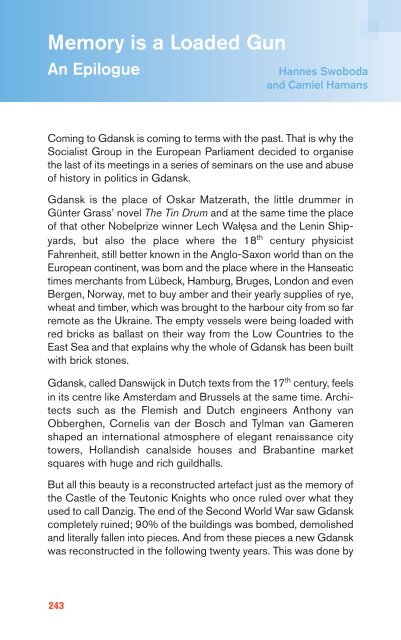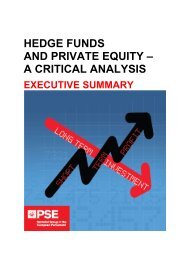Politics of the past: the use and abuse of history - Socialists ...
Politics of the past: the use and abuse of history - Socialists ...
Politics of the past: the use and abuse of history - Socialists ...
Create successful ePaper yourself
Turn your PDF publications into a flip-book with our unique Google optimized e-Paper software.
Memory is a Loaded Gun<br />
An Epilogue<br />
243<br />
Hannes Swoboda<br />
<strong>and</strong> Camiel Hamans<br />
Coming to Gdansk is coming to terms with <strong>the</strong> <strong>past</strong>. That is why <strong>the</strong><br />
Socialist Group in <strong>the</strong> European Parliament decided to organise<br />
<strong>the</strong> last <strong>of</strong> its meetings in a series <strong>of</strong> seminars on <strong>the</strong> <strong>use</strong> <strong>and</strong> ab<strong>use</strong><br />
<strong>of</strong> <strong>history</strong> in politics in Gdansk.<br />
Gdansk is <strong>the</strong> place <strong>of</strong> Oskar Matzerath, <strong>the</strong> little drummer in<br />
Günter Grass’ novel The Tin Drum <strong>and</strong> at <strong>the</strong> same time <strong>the</strong> place<br />
<strong>of</strong> that o<strong>the</strong>r Nobelprize winner Lech Wałęsa <strong>and</strong> <strong>the</strong> Lenin Shipyards,<br />
but also <strong>the</strong> place where <strong>the</strong> 18 th century physicist<br />
Fahrenheit, still better known in <strong>the</strong> Anglo-Saxon world than on <strong>the</strong><br />
European continent, was born <strong>and</strong> <strong>the</strong> place where in <strong>the</strong> Hanseatic<br />
times merchants from Lübeck, Hamburg, Bruges, London <strong>and</strong> even<br />
Bergen, Norway, met to buy amber <strong>and</strong> <strong>the</strong>ir yearly supplies <strong>of</strong> rye,<br />
wheat <strong>and</strong> timber, which was brought to <strong>the</strong> harbour city from so far<br />
remote as <strong>the</strong> Ukraine. The empty vessels were being loaded with<br />
red bricks as ballast on <strong>the</strong>ir way from <strong>the</strong> Low Countries to <strong>the</strong><br />
East Sea <strong>and</strong> that explains why <strong>the</strong> whole <strong>of</strong> Gdansk has been built<br />
with brick stones.<br />
Gdansk, called Danswijck in Dutch texts from <strong>the</strong> 17 th century, feels<br />
in its centre like Amsterdam <strong>and</strong> Brussels at <strong>the</strong> same time. Architects<br />
such as <strong>the</strong> Flemish <strong>and</strong> Dutch engineers Anthony van<br />
Obberghen, Cornelis van der Bosch <strong>and</strong> Tylman van Gameren<br />
shaped an international atmosphere <strong>of</strong> elegant renaissance city<br />
towers, Holl<strong>and</strong>ish canalside ho<strong>use</strong>s <strong>and</strong> Brabantine market<br />
squares with huge <strong>and</strong> rich guildhalls.<br />
But all this beauty is a reconstructed artefact just as <strong>the</strong> memory <strong>of</strong><br />
<strong>the</strong> Castle <strong>of</strong> <strong>the</strong> Teutonic Knights who once ruled over what <strong>the</strong>y<br />
<strong>use</strong>d to call Danzig. The end <strong>of</strong> <strong>the</strong> Second World War saw Gdansk<br />
completely ruined; 90% <strong>of</strong> <strong>the</strong> buildings was bombed, demolished<br />
<strong>and</strong> literally fallen into pieces. And from <strong>the</strong>se pieces a new Gdansk<br />
was reconstructed in <strong>the</strong> following twenty years. This was done by





